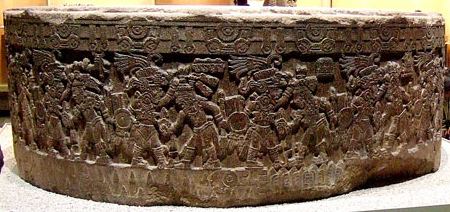Facts About Stone of Tizoc
The Stone of Tizoc, also known as the Tizoc Stone or Sacrificial Stone, is a fascinating Aztec artifact that has captivated historians and archaeologists alike. This large, round stone is intricately carved and features a shallow, circular depression on its top surface. Its original purpose remains a topic of debate, with some experts suggesting it was a cuauhxicalli, a vessel for sacrificial hearts, while others believe it was a temalacatl, used in ritual combat.
Rediscovered in 1791 in Mexico City, the Stone of Tizoc is now proudly displayed at the National Museum of Anthropology in Mexico City. Made from basalt, this impressive monolith stands 93 cm tall, with a diameter of 2.65 meters and a circumference of 8.31 meters.
One of the stone's most striking features is a series of 15 carved scenes depicting a costumed warrior capturing another warrior. These scenes likely represent the Mexica's conquests of various locations and serve as powerful propaganda for Tizoc, the Aztec Emperor. Through these carvings, Tizoc aimed to emphasize his military victories and divine right to rule.
Some interpretations suggest that the stone symbolizes the Aztec tribute system, where conquered tribes or cities would send sacrificial offerings to their conquerors. Given its design and the absence of features for securing a victim, many believe the stone was used as a cuauhxicalli, rather than a temalacatl for mock battles.

 United States
United States